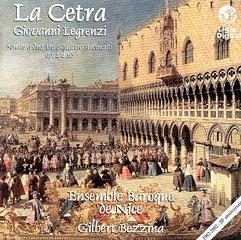La Cetra: Giovanni Legrenzi - Sonate a due, tre e quattro stromenti, Op.2 & 10 (2002)
La Cetra: Giovanni Legrenzi - Sonate a due, tre e quattro stromenti, Op.2 & 10 (2002)

1. Sonate, Op.10, No.XIV 4:37 2. Sonate, Op.10, No.XV 4:50 3. Sonate, Op.10, No.XVI 4:48 4. Sonate, Op.10, No.III 7:34 5. Sonate, Op.10, No.IV 6:14 6. Sonate, Op.10, No.IX 6:13 7. Sonate, Op.2, No.I 3:51 8. Sonate, Op.2, No.VIII 5:05 9. Sonate, Op.2, No.II 5:35 10. Sonate, Op.2, No.XV 5:55 11. Sonate, Op.2, No.VII 6:47 12. Sonate, Op.10, No.XIII 9:46 Ensemble Baroque de Nice Gilbert Bezzina - violin solo & direction
Composer Giovanni Legrenzi worked all over northern Italy in the second half of the 17th century, eventually taking the prize post of chorus master at Saint Mark's in Venice. His output was large and varied, and he helped along a variety of young genres including the instrumental ensemble sonata, two sets of which are excerpted in this release by the Ensemble Baroque de Nice. The innovations in the music are perhaps hard for the general listener to tease out, and the album, with its liner notes delving into such minutiae as the possible motivations contained in Legrenzi's wording of the dedication of one of the volumes, is probably of most interest to specialists and students of the period; the performances are straightforward but nothing more. For those bitten by the Baroque bug, however, this is worthwhile stuff. A great deal happened to the ensemble sonata between 1655, when the Op. 2 set performed here was published, and 1673, when the Op. 10 set, titled "La cetra" (The Lyre), appeared, and to listen to these pieces is to hear instrumental ensemble music emerging as a genre on a par with vocal music in importance. Both sets are for two to four instruments, almost always including a pair of violins, plus continuo. But the structures of the later sonatas are more complex, with a greater variety of moods and with small sections defining different relationships between the instruments. The generation of Corelli that followed Legrenzi, despite the growing emphasis on virtuosity, represented a simplification of what Legrenzi accomplished. These sonatas, like the rest of Legrenzi's music, would have been well known among northern Italians of his time, and the album can be recommended to anyone interested in that general scene. ---James Manheim, AllMusic Review
download (mp3 @320 kbs):
yandex 4shared mega mediafire uloz.to cloudmailru uptobox ge.tt








